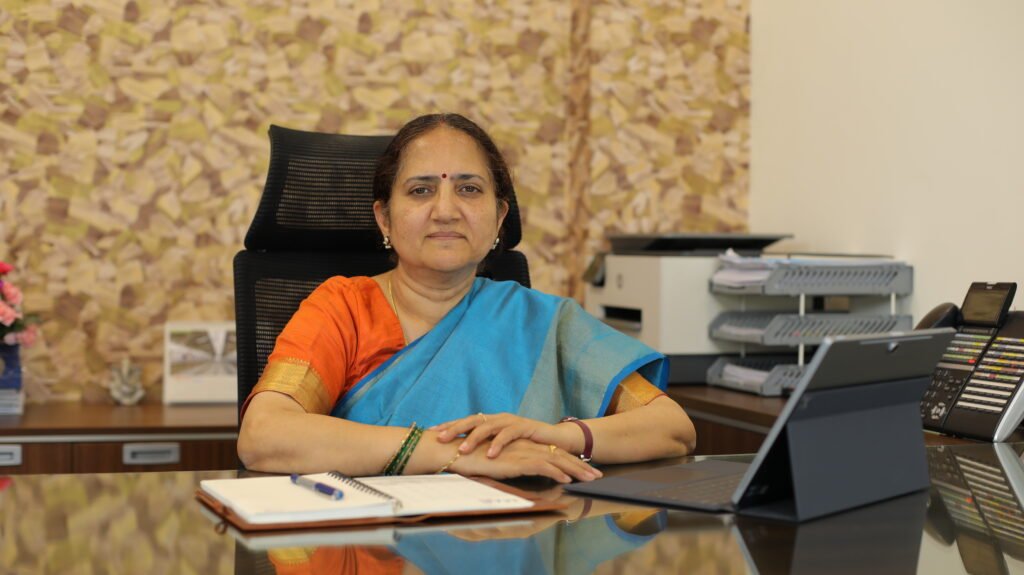Metro Rail News conducted an email interview with Ms. Namita Mehrotra, Director of Finance at the National Capital Region Transportation Limited (NCRTC). In the course of the interview, Ms. Mehrotra provided insights into her professional journey and articulated the critical role of Public-Private Partnerships (PPP) in the success of large-scale infrastructure projects, including metro and Rapid Rail Transit System (RRTS) initiatives. Furthermore, she discussed the increasing engagement of women, not only in leadership positions but also in operational roles within the sector. Ms. Mehrotra also elaborated on the impact of the Delhi-Meerut RRTS corridor on fostering sustainable development and promoting polycentric economic growth. Here are the edited excerpts from the interview.
1. Can you share your journey as Director/Finance, NCRTC? What inspired you to pursue a leadership role in NCRTC?
At NCRTC, I have had the opportunity to contribute to a transformative urban mobility project, Namo Bharat, that will set a benchmark for public transport in India. Working towards the long-term financial sustainability of the organisation excites me tremendously. In the initial stages, with a new project financing structure, there were a few challenges. Creating a team of professionals was another important activity. There were 3 multilateral banks to deal with, and rules and regulations had to be set up. It was an opportunity to draw on a clear slate, and I enjoyed it immensely. Before joining NCRTC, I had worked at Delhi Metro in the first phase, had experience in infrastructure-related policy and financing, and PPP structuring in addition to my administrative role in various capacities.

2. How has your experience been as a woman in a senior leadership role in a traditionally male-dominated sector?
As it is true for many other sectors, the transportation and infrastructure sector has traditionally been male-dominated, but I have always believed that domain expertise, strategic thinking, and a results-driven approach matter more than gender. As a woman in this leadership role, I consider myself fortunate that equity has been the hallmark of our functioning at NCRTC.
Over time, there have been positive shifts in the industry, with more women stepping into leadership as well as technical roles. The young women working for Namo Bharat are a great inspiration indeed. Young girls, including recent graduates, driving the Namo Bharat trains or taking on engineering roles in the field, be it tunnelling, inspecting installed bearings and so on, are setting examples for others to follow.
With time, companies and institutions are becoming more aware of the need for gender diversity, and initiatives to create inclusive work environments are gaining traction. However, there is still a long way to go, and the key is to provide opportunities, mentorship, and equal access to leadership positions.
3. What are some of the challenges you faced in your career, and how did you overcome them?
I have seen that each project or assignment brings its own set of challenges — be it structuring innovative funding mechanisms, achieving policy consensus from multiple stakeholders, or aligning project timelines with financial disbursements. Setting up the systems at DMRC, learning about alternate funding, setting up mechanisms for project funding through debt, setting up policy frameworks, and hand-holding for PPP projects all involved diverse challenges but were exciting to work for.
4. What are the key financial strategies that NCRTC is implementing for the success of the Delhi-Meerut Namo Bharat project?
For a large-scale complex infrastructure project like Delhi-Meerut Namo Bharat, financial sustainability is a top priority. This involves revenue generation as well as cost optimisation. This involves initiatives such as Innovative Contracting Models like long-term operations and maintenance contracts to leverage private sector efficiency as well as cost optimisation including Risk Mitigation Strategies for financial risk operationalisation of Value Capture Financing (VCF), implementing transit-oriented development (TOD) and commercial revenue streams to supplement farebox revenue. This holistic approach ensures the financial health of the project while reducing the burden on public resources.
5. What role do Public-Private Partnerships (PPP) play in funding and executing metro and Namo Bharat projects?
Public-private partnerships (PPP) can play a crucial role in the success of new-age mobility solutions by bringing efficiency, innovation, and additional funding sources. Private sector involvement can be in various forms, such as complete investment, construction and operations or outsourcing O&M activities to private players under long-term contracts for cost efficiency; engaging private players for design, manufacturing, and maintenance of rolling stock under structured contracts; and leveraging station areas and depots for commercial activities to generate non-fare revenue.
A well-structured PPP model ensures balanced risk-sharing while maintaining service efficiency and quality. PPPs have not been adopted significantly in the metros, especially due to the lumpy capital investment. However, we do have examples of full-fledged PPPs in the Hyderabad and Pune Metro projects. I would like to mention two path-breaking initiatives that we have undertaken to bring in private sector efficiency in the operation and maintenance of Namo Bharat. Through an international competitive bidding process, we selected Deutsche Bahn (DB) RRTS India for 12-year comprehensive O&M of Namo Bharat. DB RRTS India is a subsidiary of Deutsche Bahn AG, the national railway operator of Germany.
This is the first of its kind of contract in the country, in line with the vision of the Metro policy 2017, which envisages and encourages Public Private Partnership to capitalize on the resources, expertise, and entrepreneurship available in the private sector.
Another innovative step that we have taken is bundling the 15-year maintenance of rolling stock with its supply contract, which has been awarded to Alstom. This strategy has not only allowed us to optimise the lifecycle cost of the rolling stock but also transfer of knowledge and best practices to the country.
6. How do you see the role of women evolving in the metro and rail transportation sector?
Women are gradually making their mark in the metro and rail sector, not just in leadership but also in technical and operations roles. The industry is witnessing a shift, with more women taking up roles in engineering, finance, operations, and policymaking.
Organizations are also now recognizing the need for diversity in decision-making and operational efficiency. With increasing automation and technology-driven solutions, traditional barriers are being removed, enabling women to contribute significantly to infrastructure development.
Namo Bharat serves as a prime example of how gender inclusivity is being embedded into the core of transport infrastructure. The design and implementation of Namo Bharat prioritizes women’s safety, convenience, and accessibility.
Moreover, women have been integral to the leadership and execution of Namo Bharat, with women engineers spearheading complex civil works, digital innovation, and high-tech systems integration. This shift reflects a broader industry trend where women’s involvement is not just in passenger-facing roles but also in critical decision-making and operational functions.
With the increasing representation of women at leadership levels and technical functions, the sector stands poised to benefit from their unique perspectives, contributing to more sustainable, efficient, and future-ready transport systems.
7. What initiatives shall be taken to encourage more women to take up leadership and technical roles in infrastructure projects?
To encourage more women to take up leadership and technical roles, the industry needs to focus on providing industry exposure and leadership training to young professionals; ensuring flexible work environments within Government policy framework, safety measures, and equal opportunities for career advancement; and encouraging women to take up STEM education and specialized certifications in transport and infrastructure finance. For example, many young women, straight out of college, have been provided extensive training and are now working in crucial roles like Train Operators and Station Controllers for efficient O&M of India’s first Namo Bharat project.
8. Are there any initiatives within NCRTC to promote gender diversity and inclusion?
At NCRTC, we have implemented extensive women-centric initiatives to ensure inclusivity and safety on the Delhi-Ghaziabad-Meerut Namo Bharat corridor. Namo Bharat trains feature a dedicated women’s coach, reserved seating, CCTV surveillance, and well-lit stations with nursing rooms and women’s restrooms.
Our efforts include hiring 88 women in operational roles, with women comprising 44% of the operator’s workforce. NCRTC also supports women from local communities along the Namo Bharat corridor through initiatives under the Japan Fund for Prosperous and Resilient Asia and the Pacific (JFPR). 500 women have been provided e-mobility training and vocational skills, and more than 900 girls have received self-defence training.
Gender-responsive efforts extend to training/ outreach programs for public transport staff, which play a crucial role in gender sensitization & mindset evolution, and providing gender-inclusive amenities in the new-age mobility solution i.e. Namo Bharat.
9. As the Namo Bharat projects expand to other cities in India, how do you envision their potential to strengthen urban transportation?
The expansion of Namo Bharat projects to other cities in India is a step towards building a sustainable and efficient regional transport system. The key impacts include sustainable and polycentric economic growth; job creation along the transit corridors; planned urban development; faster access to healthcare, education, employment and leisure; and reduction in congestion and carbon emissions through a shift from private vehicles to public transport. With a robust funding strategy and integrated planning, Namo Bharat has the potential to reshape regional mobility in India and contribute to sustained economic growth.
10. What message would you like to share with the readers of Metro Rail News?
Metro and rail transportation are at the forefront of urban transformation in India. As we move towards sustainable mobility solutions, collaboration among policymakers, industry leaders, and financial institutions will be key. An integrated transit and economic development approach is the way forward. This is also the idea behind the Hon’ble Prime Minister’s visionary National Gati Shakti Master Plan.
For the young professionals, I would encourage them to explore opportunities in infrastructure financing, project development, and policy planning. The future of urban mobility depends on innovation, inclusivity, and financial sustainability, and I am excited to see how the next generation of leaders will drive this change.





